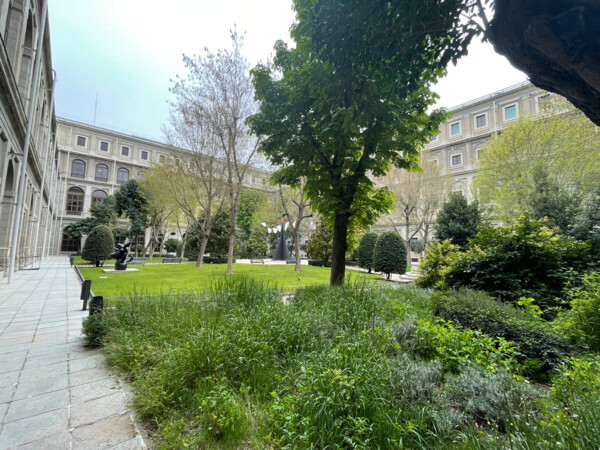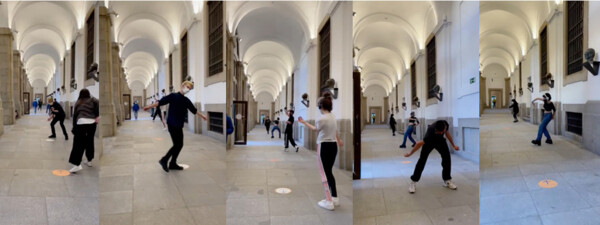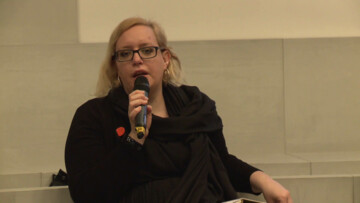In her book Timefulness, Marcia Bjornerud recounts the thrilling story of how the age of the → Earth was determined. Much of her chronicle revolves around the idea of deep time, a concept nearly equivalent to that of geological time, but with a nuance that connotes the human inability to really comprehend its scale. Becoming conscious of its presence, however, can serve as a counterpoint to the other, more common and daily experience of time, recently accelerated by the free-fall of eco-social collapse.[1] The idea of deep time provides us with a lens, a tool of resistance to rethink or – better yet – to try to re-experience time in a different way. In an institution like the Reina Sofía Museum certain temporalities become central: the recently inaugurated Collection, for example, proposes a reading of the present drawing upon a critical study of a common past framed by the period between 1881 and 2021. On the other hand, the circadian rhythms of the museum’s openings and closings, the duration of its public activities, or the speed at which various human groups move through the space mark the presence of another more concrete, more experiential temporality, that crystallises into a kind of chrononormativity, to use Elisabeth Freeman’s term.
Chrononormativity is a mode of implantation, a technique by which institutional forces come to seem like somatic facts. Schedules, calendars, time zones, and even wristwatches inculcate what the sociologist Eviatar Zerubavel calls “hidden rhythms”, forms of temporal experience that seem natural to those whom they privilege. Manipulations of time convert historically specific regimes of asymmetrical power into seemingly ordinary bodily tempos and routines, which in turn organize the value and meaning of time. The advent of wage work, for example, entailed a violent retemporalisation of bodies once tuned to the seasonal rhythms of agricultural labour.
Since I’ve been working in the Museum, there have been many spaces of debate around the physical restrictions in place here, about the performative barriers the institution erects or the accessibility (and/or inaccessibility) of its programmes. On the basis of these debates, we’ve reformulated calls for participation in an effort to seek greater contact with communities that we wanted to include in the life of the Museum. In contrast, very rarely have we questioned the problem of temporality. But the process of certain projects and experiences, like El Jardín de las Mixturas,) Serenity Rave, or Savia, have shaken (in more or less apparent ways) the regimes associated with a certain way of experiencing time that have been validated by the institution as “natural” or have been accepted by default. They have opened the possibility of what we might call constituent temporalities. These constituent temporalities have entered into the life of the Museum with varying degrees of friction, duration and visibility, and they have done so in an unregulated way, in plain sight of everyone.
The grass of the interior garden of the Sabatini building of the Reina Sofia Museum is still, for the most part, well-watered and exquisitely trimmed by Isaac, the Museum gardener. Fences delimit the planted areas; while low, they still dissuade people from stepping over them and walking on the grass. As part of the exhibit El Jardín de las Mixturas: Tentativas de hacer lugar 1995–... by Alejandra Riera, to be inaugurated on May 4th, since 2017 two of these planted areas have been “liberated” and their → care (→ care) has been handed over to a diverse community of persons, including some Museum workers and others who don’t belong to the institution. (Figure 1) This has entailed a new system of manual watering more appropriate to the Madrid climate, the removal of the low fences surrounding these areas, and the de facto creation of a diverse and changing community that continues sharing knowledge and responsibilities, embodying the idea of communitas proposed by Roberto Esposito: “a body of persons who share a task”.[2] Of all the transformations generated by this project over its five years of life, here I will focus on those that resonate with the temporality of the institution.
 Figure 1: Alejandra Riera, El Jardín de las Mixturas: Tentativas de hacer lugar 1995–, 4 May – 5 September 2022, Museo Reina Sofía. Photo: Fran MM Cabeza de Vaca.
Figure 1: Alejandra Riera, El Jardín de las Mixturas: Tentativas de hacer lugar 1995–, 4 May – 5 September 2022, Museo Reina Sofía. Photo: Fran MM Cabeza de Vaca.
The main one, from my perspective, is the emergence in the very heart of the Museum of a portal to a direct experience of a form of deep time. This is provided by non-human life that, for the first time, takes on the appearance and presence of non-domesticated nature: not overly tended by radical anthropocentrism. The formal principle of the French garden that has dominated the rest of the compound for decades minimises the effects, for example, of the characteristic dryness of hot Madrid summers, instating a permanent illusion of halted time (halted, moreover, in a non-existent mild climate, alien to this location). Through the transformations of the Jardin de las Mixturas, the real summer, spring and fall become present and visible in the interior of the Museum, favouring an awareness of cycles that have heretofore been attenuated by the air conditioning of the interior and the static landscaping of the garden. One need only sit on one of the benches that have been placed inside the planted area (yes!) of the Jardin de las Mixturas and observe carefully in order to receive a message of a very different temporality, that appeals to a trans-historical flow of time: that of vegetation, lichens, microorganisms and insects, as well as all those beautiful beings that have planted their hearts in it.
Within the community that cares for the garden a new temporality has emerged that has to do, for example, with the ideal times for watering, work shifts that avoid the hours of the most extreme temperatures, or the periods of waiting imposed by different plant species. These temporal threads also had to be woven together with the office hours of the Museum workers in a process of self-regulation and an active occupation of time that in principle was not devoted to this purpose. Thus without any clear institutional guideline or hierarchical orders to this effect, an experiment in a constituent → process has taken place in relation to the agency involved in the management and use of time.
A collective body of ten young people who are members of equipo1821 dances in the garden, halls and rooms of the Museum in each session of Serenity Rave, a physical practice of the choreographer Laura Ramírez Ashbaugh. (Figure 2) This generates a liminal state of presence/absence, accompanied by electronic music through headphones. As in all dance, time is suspended.

Figure 2: Laura Ramírez Ashbaugh, Serenity Rave, 2021, video frames of a video session, Museo Reina Sofía.
When explored in collective, the transformative power of performance – art linked so radically to an alternative notion of time – reverberates in this celebration with another idea of communitas, a concept proposed by Victor and Edith Turner and cited by Victoria Pérez Rollo in her essay “Corporalidades Disidentes”. Party and politics on the contemporary stage, speaking to us about the “pleasure of a human group that shares common experiences in which distances and hierarchies are temporarily abolished, as are the structures that order daily life”. Which leads us to other terms, like “joy, → empathy, liberatory interconnection, (or) the creation of enduring bonds […]”
If we were to do what Silvio Lang proposes in his Manifiesto de la práctica escénica and “talk less about ‘works’ and more about ‘practices’”, we would once again be shifting our attention towards the time for being, doing and becoming, rather than the products and objects that these practices produce, so central to the communication and archives of institutions. Understanding, living and narrating community as a verb. As time. We can reread the calls for participation, listen to the reports, and look at the photographs that were taken in these encounters in order to demonstrate once again – in contrast to the lived experience itself – the irremediable failure of the attempt to fix in time that which resists this treatment. In community experience, as in the performance time is all we have.[3]
In this the temporal experience generated by the appearance of twelve young people dancing in a group in sessions of 15, 30 or 60 minutes, establishes a rupture in normative time, a pause that not only produces effects upon those who are immersed in the music and dance, but also upon those who stop to look and therefore enter into what Erika Fischer-Lichte[4] calls the autopoietic feedback loop. The value of these pauses resides not only in their ephemeral emergence – powerful and magical though it is – but rather in the potential → emancipatory power they possess, suggesting other ways of being in time inserted within the normative time of the visit, the itinerary or even the pause to rest. Following Elisabeth Freeman:
Pauses or interruptions in the routinized rhythms of everyday life, in the sequences expected to unfold naturally from one another, become the material for a peoplehood experienced as pre- or a-political, as merely human. In describing the narrative texture of modern nationality, Homi Bhabha too refines the distinction between linear-historical time and the more static times of cyclic and monumental time: he describes the dialectic between a “pedagogical” time in which historical events seem to accrete toward a given destiny, and a “performative” time in which a people recreates itself as such through taking up a given activity simultaneously.[5]
Finally, if there is any collective that inhabits its own temporality it is children, who have no compunction about voicing the consequences of any effort to squeeze their temporality into our adult agendas through hurry (and sometimes calm). Free play, the ultimate experience of flow, is one of the most perfect ways to experience the passage of time in a completely different way. Based on this premise, the project Savia, developed in different formats and editions in the Museum since 2019 in collaboration with the collective La Parcería Infancia y Familia and oriented to children aged between 0 and 7 years and the adults who accompany them, centres its methodology and some of its proposals on opening up time for free play. We might say that the majority of the activities for children that cultural institutions propose – including some of the activities within Savia – are based on a sequential outline of actions that work well for some children and, above all, that fit perfectly into the adult logics of how time should be organised. But a proposal based on free play grants temporal agency to the children themselves, who decide whether the activity will last five minutes or thirty, and in the course of the activity – as also in the case of the dance – a different temporality emerges, into which the accompanying adults can either enter or not, but which certainly opens an alternative space, a door, a different way of flowing with a texture entirely different from a productive or sequential temporal logic.
Conclusions
Ursula K. Le Guin, in her Carrier Bag Theory of Fiction, said:
We’ve all heard about the sticks and spears and swords, the things to bash and poke and hit with, the long, hard things, but we have not heard about the things to put things in, the container for the thing contained. That is a new story. That is news.[6]
I dare to establish a parallelism and in this way shift attention from the products, the projects and actions, and toward the temporalities in which these take place: temporal experiences that function more like a continent than like content, and that profoundly condition the possibility of some ways of being (and some ways of not being able to be). From that vantage point we might observe and discuss which changes to implement in order to favour the coexistence of different temporalities.
Can institutions detect, receive and accompany experiences that open cracks in the chrono-norm?
Can these experiences shape chrono-normativity and permanently establish lines of flight within it?
Do calls for participation, for example, or registration deadlines or beginning and ending dates for activities make sense when we are promoting experiences that aim to be community-based?
Are the organisational and productive logics of the institution compatible with the indomitable temporal needs of certain life processes?
What strategies might we develop to favour and make possible real temporal agency on the part of the communities with which we live?
If time is no longer a line but rather a spiral, a loop or a cloud bank, then according to Bruno Latour all that is left to us is “to shift our attention (and) actively select elements that pertain to different times”.[7] And to stop to listen, from that vantage point, to what time does with the communities that inhabit the Museum: it modifies and remixes us, it resignifies, expels, heals and sickens us, it challenges us and endows us with meaning. And also and especially, to listen to what communities do with time and with the temporality of the Museum.
Perhaps anchoring our visions and our desires in a deep time perspective might lend solidity to our efforts to defend diverse temporal experiences of and for the commons. Perhaps it might help us navigate upstream in this end-of-the-world against which there is no option but rebellion.


